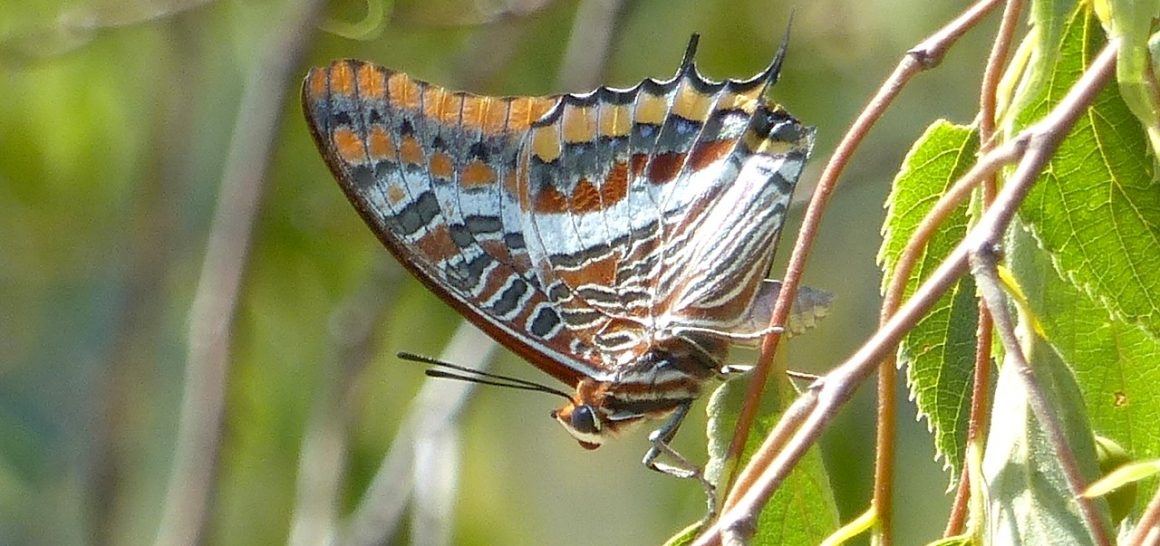This fearsome creature was within an inch of being crushed by my heedless foot… but luckily it made a surprisingly agile lurch to one side just in time. I had no idea what it was, other than the largest caterpillar I have ever come across. Everyone else will know, of course, that it is the childhood form of what will become an elephant hawk-moth Deilephila elpenor. I haven’t knowingly seen one of those either.
NOTE Aug 2023. This post from 2017 on this largely defunct site was has attracted a lot of hits this month. It gives an excellent example of APOSEMATISM, defensive appearance and / or behaviour designed to repel predators. The Wiki link above will take you to a very good article on this topic, and is highly recommended if you want to know how animals of all kinds have developed many and varied protective methods
These caterpillars have three ‘poses’. The first is the usual day-to-day one, as it goes about its business with its little snout – or ‘trunk’ – extended. Note the four prominent ‘eye’ markings behind the head.
At the threat of danger, the caterpillar assumes its ‘elephant’ pose, tucking away its snout and humping its front end so that the 4 ‘eyes’ glare intimidatingly. From the front, there is the hint of a mouth, with two sharp eyes above it.









They certainly are amazing.
LikeLiked by 1 person
So do you have these – and the actual moths? Totally new to me!
LikeLike
Yes although I haven’t caught up with one they are seen locally and this year has apparently been a goodyear for them.
LikeLiked by 1 person
Great photographs! It is an impressive caterpillar. I have seen the privet hawk moth in the garden which is a similar colour moth but I suppose must be smaller. Amelia
LikeLike
Thanks! Glad I didn’t squish it. As for your moth, au contraire… apparently it is ‘…our largest resident hawk-moth…’ which presumably goes for France too. The next day we had 3 granddaughters under 6 staying – I tried to locate the caterpillar for their delectation, without success. Profoundly unimpressed by mere photos!
LikeLiked by 1 person
I remember an encounter similar to yours where I also nearly squashed one of these impressive caterpillars on a path.
LikeLike
Impressive for sure, and doubtless messy when squished. Glad I saw it in time. Now I know what the adult (imago????) looks like, I’ll need to keep an eye out. At least it can’t be confused with any other moth! RH
LikeLike
Stunning! Seem to be a lot of the caterpillars around this year.
LikeLike
Did you see this: https://www.theguardian.com/environment/2017/aug/31/an-elephant-wanting-a-room-hawkmoth-on-the-move-for-pupal-lodgings?CMP=share_btn_tw
LikeLiked by 1 person
No! Many thanks for the link!
LikeLike
Just had one of these in our kitchen didn’t take a pic just picked it up and put in garden in Kent
LikeLiked by 1 person
Thanks Kim. Glad if it helped ID. Recently found a bright green one (earlier stage) – must add to the post. Great summer for moths
LikeLike
Exciting find! I recently found a bright green EHM caterpillar – I’d only seen brown before but apparently that’s a later stage… Thanks for calling in
LikeLike
Hi just seen a elephant hawk moth going across our garden about 3″ long , minster-on-sea Isle of Sheppey
LikeLike
Strange creatures! Their appearance is an excellent adaptation to deter predators (‘aposematic’)
LikeLike